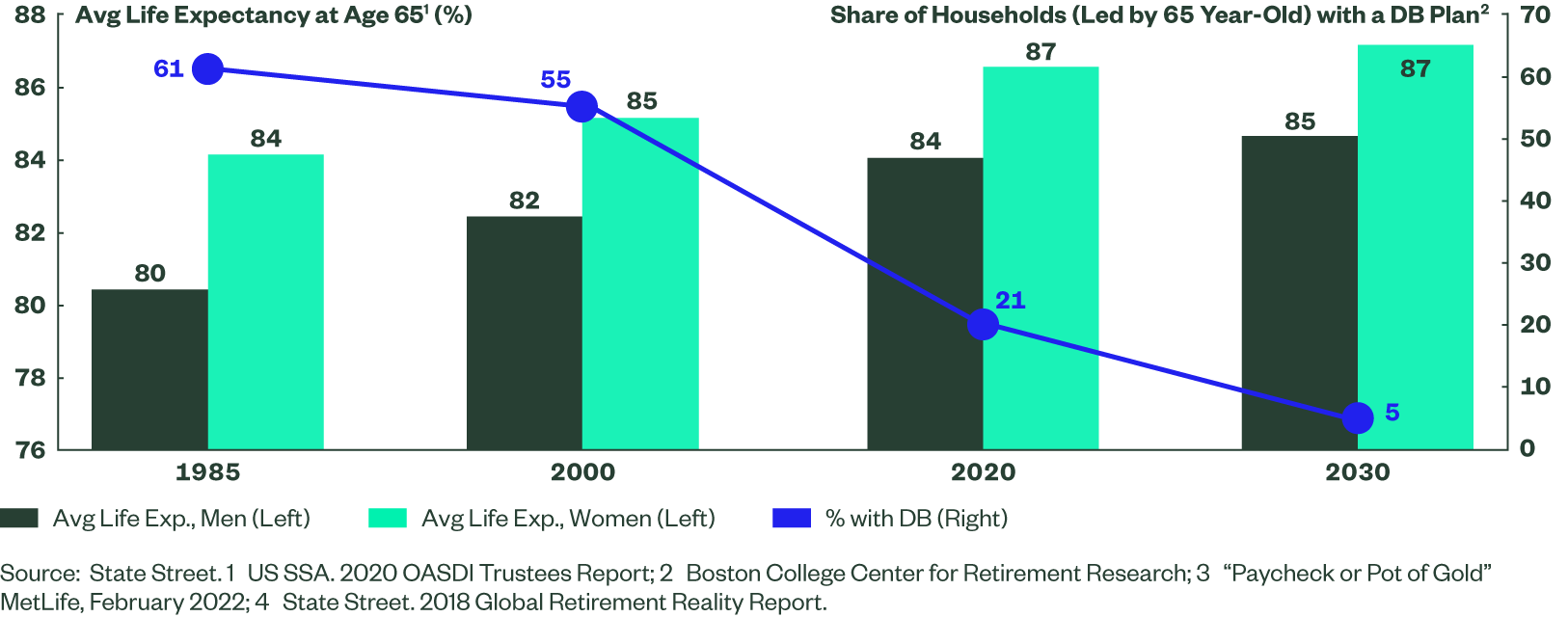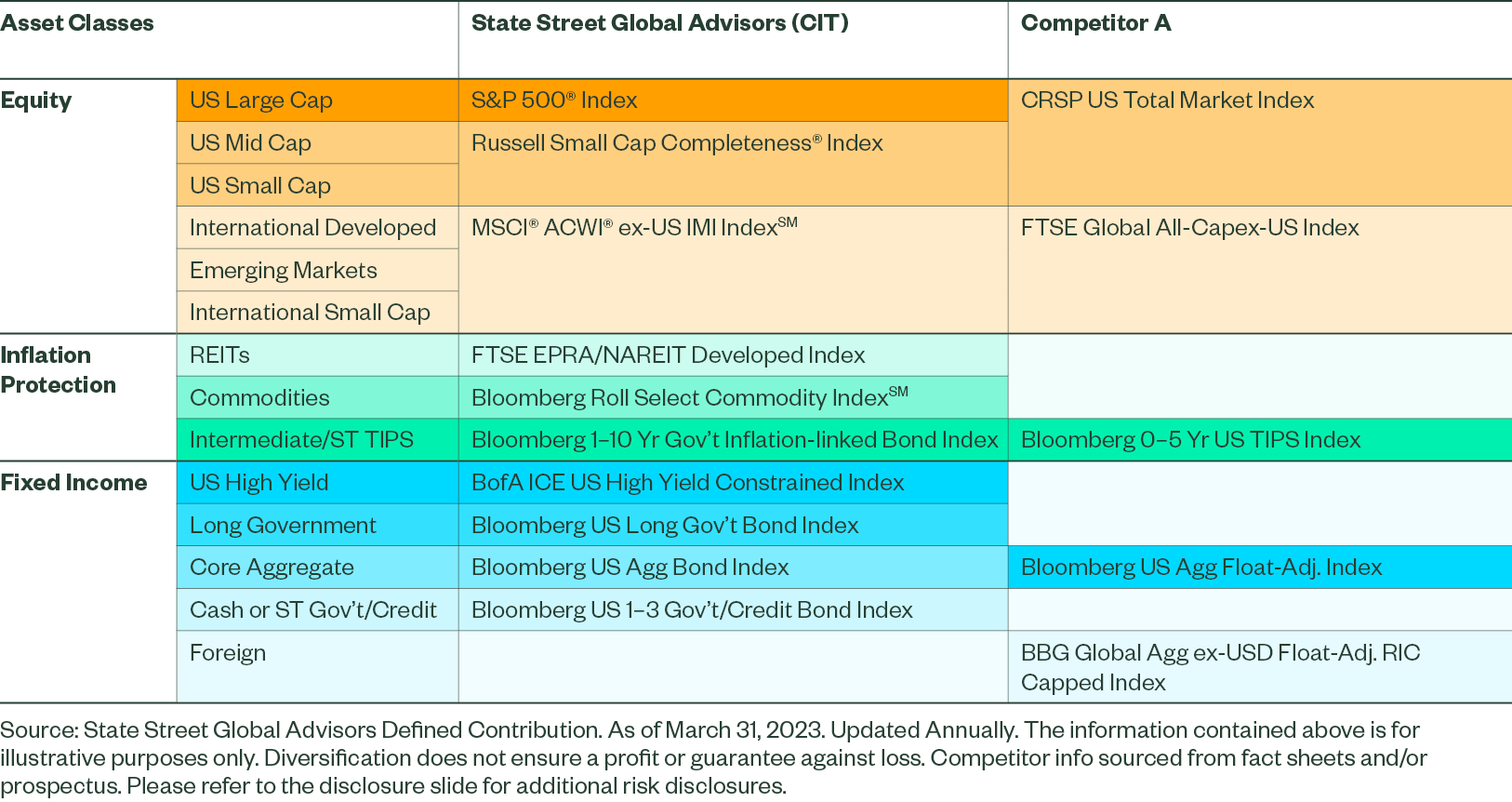Evaluating Retirement Income Solutions? First, Check Under the Hood
The shift from defined benefit to defined contribution plans as the primary savings vehicle for Americans has been talked about for so long that many may be numb to it. But if you look closely, what was once a marathon process that took decades to fully materialize has nearly run its course.
At the turn of this century, 55% of retirees had a pension benefit. By 2020, while that number had declined precipitously, a still meaningful 21% of retirees could rely on the stable income that a defined benefit plan provided. By 2030, this is expected to drop further to 5%. In other words, by the end of this decade – and we’re nearly half way through it -- pensions will effectively be a thing of the past.
Figure 1: Increasing Need for Income Solutions Given Decline of DB Plans and Longer Life Expectancies

As longer life expectancy and disappearing pensions increase urgency, DC plan sponsors and intermediaries have begun to rigorously analyze guaranteed income solutions to support participants efficiently spending their assets in retirement without fear of running out of money. But from the employer’s perspective, adding a lifetime income solution requires a number of considerations beyond the income vehicle itself. Retirement Income is a new category and benchmarking income solutions amidst the broad range of objectives and product structures can be challenging. Here we offer why we believe Target Date Funds are the proper foundation, and why the evaluating the right glidepath plays a key role in maximizing the value that guaranteed income can offer.
Choosing the Right Packaging
The most -- some might say only -- effective means to drive adoption of defined contribution investment options is through the plan default. Over 80% of plan participants today use Target Date Funds as their wealth accumulation vehicle. Target Date Funds provide a low-touch, professionally managed approach to building wealth over long time horizons. While programs that offer annuity purchases through the core menu or brokerage window are helpful in providing plan participants with choice, historical participant behavior suggests that very few exercise that flexibility and fewer have the knowledge necessary to make an optimal decision around guaranteed income purchase. Building off of the Target Date framework to offer participants the structured choice to convert to a lifetime income stream is likely the most effective and seamless means to meaningfully impact participant adoption, and ultimately improve outcomes.
For an income solution to work, it needs to add value without compromising the many things that Target Date Funds do well – simplicity, efficiency and (in most cases) liquidity. How each manager addresses liquidity, portability, costs and the participant experience will be key differentiators in which income solutions gain traction. But the traditional measures of comparison should not be lost in this process. A well-designed glidepath will continue to be key to supporting participants throughout retirement. To highlight this, we offer three key questions that investment decision makers should ask as they consider default solutions with guaranteed income.
- Does the solution deliver value for fee?
- Is the Target Date glidepath designed to deliver consistent outcomes in line with stated objectives?
- Will Retirement Income compromise what is already working?
Delivering Value for Fee
The State Street Target Retirement glidepath uses a strategic, index-based approach to asset allocation. Focusing on long-term views and avoiding tactical decisions allows us to deliver a straightforward, intuitive approach to risk management while keeping costs low. Using a broad stable of asset classes promotes efficient portfolios in concert with participant objectives at each stage of their careers. The ultimate goal is to provide meaningful levels of real income replacement in retirement -- whether that is delivered through traditional measures or by converting to a lifetime income stream.
Figure 2: Asset Class Diversification — Index Managers

State Street’s broadly diversified approach allows us to break out exposure within equities, bonds and inflation sensitive asset classes in order to express a view on the most appropriate mix of characteristics at each stage of participants careers. For example, we hold a longer duration fixed income allocation for younger investors due to the diversification benefits that longer duration bonds offer in equity-heavy portfolios, and strategically reduce that duration over time as participants hold more fixed income and interest rate risk becomes of greater concern. Similarly, rather than using one fund to provide broad (but static and inflexible) exposure to US equity markets, State Street builds in a structural overweight to Small and Mid-Cap stocks for younger investors. Stocks of these companies offer investors greater long-term growth expectations in exchange for higher volatility — a tradeoff that can be more appropriate for investors with long time horizons. As participants age and priorities change, this structural overweight is strategically reduced.
State Street’s scale and experience as an index manager is the key to delivering this broadly diversified solution at low cost. As testament to the value of our approach, State Street’s Target Retirement strategies have grown from $66 billion in 2018 to $163 billion as of March 31, 2023.
A Thoughtful Glidepath is Key to Successful Outcomes
There is unlikely to be a “one size fits all” income solution that will fit all plan demographics and participant needs. However, one fact will always apply – a higher accumulated balance at retirement will lead to more meaningful retirement income.
State Street’s glidepath is designed to balance wealth accumulation goals with volatility and inflation risks as participants approach retirement. The strategy uses five underlying funds to evolve our fixed income asset allocation intelligently as participants get older. As retirement age approaches, we add more diversified fixed income exposure, pairing US aggregate bonds with short duration exposure to reduce volatility and protect against the impact of rising interest rates. By breaking out our fixed income exposure, State Street’s diversified approach provides more control, and greater emphasis on interest rate risk than what is typically found in passive solutions.
Additionally, a key limitation of most guaranteed income vehicles is that inflation adjustments are prohibitively expensive in terms of the impact on income. As a result, inflation is a key risk for participants regardless of whether they elect lifetime income. State Street incorporates three inflation-sensitive asset classes, Commodities, REITs and TIPS, in order to provide a portfolio designed to be more resilient in periods of rising inflation.
What does this look like in practice? Analyzing fund vintages that are closest to retirement today where guaranteed income may come into play, State Street’s fund vintages have delivered strong peer relative returns over long time horizons. Below, we highlight the fund vintages closer to retirement over the last fifteen years. In the two vintages most likely to be held by today’s retirees, State Street’s Target Retirement Collective Investment Trust series has outperformed 96% of peers. These key wealth accumulation years have the greatest impact on retirement, as participants typically have their largest balance in these years and the impact of investment returns, and risk management, is highlighted.
| Period Ending March 31, 2023 Morningstar US Peer Universe Percentile Rank(%) |
15 Year Ranking |
| State Street 2035 (Net 12 bps) | 19 |
| State Street 2030 (Net 12 bps) | 12 |
| State Street 2025 (Net 12 bps) | 3 |
| State Street 2020 (Net 12 bps) | 4 |
| Average Rank (%)* | 10 |
Seamless Integration
A consistent concern expressed by investment decision makers in the adoption of retirement income solutions has been liquidity and portability, both at the plan and participant level. Approaches that incorporate annuities directly into the glidepath have the potential to limit growth, add costs, and impact flexibility for plan sponsors who wish to make a change to the plan default.
Further, if not implemented properly these features may disadvantage participants who do not ultimately benefit from the lifetime income feature. For example a participant who switches jobs (the average participant is expected to hold 12 jobs throughout their career) may have paid higher fees throughout their tenure for a feature that they likely will not benefit from. Additionally, solutions that add investment management expenses while offering participants the option to add lifetime income may be harming those who do not make that election.
By using index-based building blocks throughout the glidepath, State Street is able to leverage scale in order to manage costs while not introducing illiquid components or increasing investment management fees at any point in the glidepath. This ensures that participants do not compromise what is working today – namely the low-cost, liquid and efficient approach to wealth accumulation that Target Date Funds offer – while adding a lifetime income plan for those who want it.
Conclusion
Choosing a Target Date manager is about selecting the right long-term partner to work with your plan towards delivering retirement readiness. While the newer features of retirement income are justifiably a key area of focus, it is important not to forget about the foundational attributes that can drive successful retirement outcomes. For plan sponsors considering incorporating retirement income into their plan default, these attributes should be considered in tandem rather than in isolation.
We believe now is the right time to engage in conversations around retirement income solutions, drawing on progress made by the asset management, recordkeeper and plan sponsor communities in addressing the many hurdles that come with innovative change. State Street offers unique insights in this regard – having deep experience working with the many stakeholders necessary to successfully implement a solution.